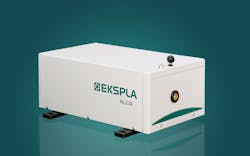The NL230 line of DPSS Q-switched Nd:YAG nanosecond lasers produce pulse energies up to 50 mJ at 100 Hz or up to 140 mJ at a 30 Hz pulse repetition rate. Diode pumping allows maintenance-free laser cavity operation for >3 years. Applications include material ablation, remote sensing, and OPO, Ti:sapphire, or dye laser pumping.
EKSPLA
Vilnius, Lithuania
[email protected]
More Products
-----
PRESS RELEASE
New line of DPSS nanosecond lasers offer extended maintenance-free period
EKSPLA has announced a new line of DPSS Q-switched Nd:YAG lasers. The new NL230 series of nanosecond lasers produce pulse energies up to 50 mJ at 100 Hz or up to 140 mJ at 30 Hz pulse repetition rate. Diode pumping allows maintenance-free laser cavitry operation for an extended period of time (more than 3 years for an estimated eight working hours per day). The typical pump diode lifetime is more than 1 billion shots.
Lasers are designed to produce high-brightness pulses and are targeted for applications such as material ablation, remote sensing, OPO, Ti:Sapphire or dye laser pumping. Thanks to an electro-optical Q-switch, the pulse duration is in the 5-9 ns range. A closed-loop chiller is used for laser cooling, eliminating the need for external cooling water and reducing running costs.
Wide range of available accessories enables to tailor NL230 for various applications. Harmonics options are available for 532 nm, 355 nm and 266 nm wavelength output. The harmonics separation system is designed to ensure radiation with a high spectral purity and to direct it to the separate output ports.
For customer convenience, the laser can be controlled via a user-friendly remote control pad or a USB interface. The remote pad allows easy control of all the parameters and features a backlit display that is easy to read even through laser safety eyewear. Alternatively, the laser can be controlled from a personal computer via a supplied Windows⢠compatible software. LabVIEW⢠drivers are also included with each laser installation package.
-----
Follow us on Twitter
Subscribe now to Laser Focus World magazine; it's free!
